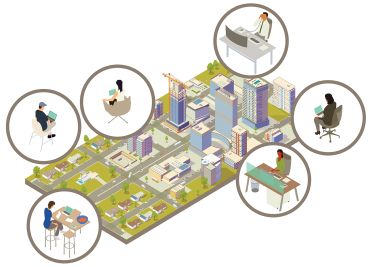Durst Tower Tallest Multifamily Building to Feature View Smart Windows
Developer and proptech firm added AI-powered portals to the 755-foot Sven tower in Long Island City, Queens
By Philip Russo February 1, 2022 9:00 am
reprints
The Durst Organization has installed View smart windows in its recently completed, 67-story Sven apartment tower in Long Island City, Queens, making it the tallest residential building in North America to feature View’s technology.
The developer and the proptech firm plan to jointly announce the installation on Wednesday.
Although smart windows have become increasingly common in office buildings, it was a case of seeing is believing for Durst to decide to use the technology in the 755-foot Sven.
“We have worked on collaborations with View before on the commercial side,” said Dan Mogolesko, senior vice president of residential at Durst. “To our knowledge, this had never been done on a large scale on the residential side.
“So an opportunity to work with View and to have that experience for the renter, where they can maintain [an unobstructed] panoramic view while keeping their blinds open, but also having the ability to control the tint for privacy purposes without lowering their shade, has been received really well by prospective renters and those that have started renting in the building.”
Durst brought View into the Sven project later in its development, which led to the company’s smart windows being installed only on the south-facing facade overlooking Manhattan, both companies confirmed.
Sven is the third Durst-owned tower to feature View smart windows, following the office buildings at 825 Third Avenue and 1155 Avenue of the Americas. Durst is one of the country’s leading developers, owners and managers, with 13 million square feet of office space and 3 million square feet of residential.
Owners and developers’ growing willingness to pay a premium for View’s smart glass product in their multifamily residential properties — and to add a premium cost for renters — as well as in commercial office buildings, has opened another sector of the real estate market for the Milpitas, Calif.-based proptech company founded in 2008.
Apartments in Sven that have View’s smart windows rent for “$100 to $150 a month more” than similar dwellings in the building, said Mogolesko. He said that no prospective renter failed to take an apartment due to the added cost.
Monthly rents for Sven’s studios “are in the $3,100 range and our one-bedrooms right now start at $3,900 and go up to about $5,000, with two-bedrooms starting at $5,200,” he added. “Our three-bedrooms start just a little bit over $6,000.”
“If you look at the product applicability, it’s basically for any building that has a lot of windows,” said Rahul Bammi, chief business officer at View. “We did not, candidly, start off years ago with residential as a focus area. But the product design doesn’t preclude it. Now, housing has picked up massively in the last three or four years for us.
“Having said that, we did focus first on office buildings, airports and hospitals,” Bammi added. “All three of those are categories where there are large buildings with a lot of windows. Their energy consumption is high and that’s where as people we spend a lot of the daytime hours, basically indoors in office buildings or in hospitals. The health benefits in hospitals are very obvious. The medical community has known for a long time that natural light is good for people.”
Durst is not the only developer moving toward using smart windows in residential and other properties. The company’s long been a leader in sustainability in real estate — a trend in the industry that’s only grown the last several years. In short, owners and developers want to be known for being green.
Among View’s other projects in New York City is the soon-to-be completed Delta terminal at LaGuardia Airport.
Additionally, the most recent View multifamily installations in the U.S. are via a partnership with Nabr, the home design company launched by architect Bjarke Ingels, that will have View’s smart windows in all its properties. SoFA One, the first Nabr development, is being built in San Jose, Calif.
Additionally, View’s product is in EXO Apartments, an apartment complex in Reston, Va.; Fenway Center, the first residential building at the Fenway Center in Boston; 80 Bond, a residential development designed by Atria Development in Toronto; and Carlisle Square, a residential development in Ontario designed by Nickel Development.
View’s smart windows use artificial intelligence to automatically adjust to control heat and glare without the need for blinds. This can reduce energy consumption from lighting and HVAC by as much as 20 percent, while generating health benefits for building occupants, according to the company. Residents living in buildings with View smart windows slept 16 minutes longer and experienced 11 percent less anxiety compared to those living in homes with traditional windows and blinds, according to a recent study.
The technology embedded in View’s smart windows, which the company itself manufactures, is “deceptively simple,” said Bammi. “We have a lot of people who came from the semiconductor industry. I myself come from semiconductors. Basically we applied that nanoscale technology to solve this problem. And the electrochromic films we use, the entire stack we put [on the window glass] is one micron thick. Our hair is about 75 microns thick, so it is a very thin kind of sophisticated technology. We have over 1,200 patents that we’ve either gotten or are being applied for. So there’s a lot of hard science that’s gone into it.”
Landlords and tenants control their windows through a cellular box on the building’s roof, which is hooked into the property’s existing cable tree and is backed up by View’s own network operating center in Milpitas, said Bammi.
“Each property has its own network,” he said. “We develop just like Tesla does. If you look at the analogy there, the software [in a Tesla] has improved over the last six years even if you bought a Tesla six years ago. [Similarly], we improve our algorithms as people live in buildings and we discover new kinds of situations. We do over-the-air software upgrades to make the building function better. So any building that installed View five years ago is functioning slightly better today than it did five years ago.”
View has also developed an app that allows tenants to control their smart windows, including limiting light emitted from their dwellings at night, which reduces light pollution in communities, Bammi added.
Durst joins a growing list of multifamily developers across North America, including Greystar, The Green Cities Company, Atria Developments and Henbart, offering View smart windows as an amenity.
Philip Russo can be reached at prusso@commercialobserver.com.


